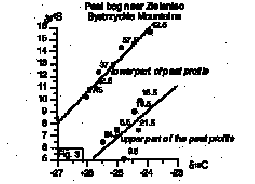



Sulphur and carbon and isotope analysis (Figs. 1 and 2) and organic sulphur concentration measurements have been carried out in two peat profiles from SW Poland (Zieleniec and Szrenica) and three peat profiles from S Thailand (Bacho I & II and To Daeng). These profiles represent the last two thousand years. It seems that the main factor controlling carbon isotope ratio in peat is temperature and perhaps water level on the peat bog, and the main factor controlling organic sulphur isotope ratio in peat is water level. In general, all the profiles examined show coincidence in carbon isotope variation in time. It may prove that global climatic variations are recorded in peat. In the younger-most levels of peat, distinct shift of the d13C into negative direction may be resulted by increase in anthropogenic carbon dioxide coming from fossil fuel combustion. d13C and d34S variation evidence that climate cycles may vary with time in a matter of less than 100 years. Small see-level increase in the SE Thailand, from VI to XII century was probably local. The d13C-d34S plot (Fig.3, numbers near points represents depth in the profile in cm) show that the lower part of the Zieleniec profile represents shallow lake vegetation and sedimentation and the upper part represents typical high peat bog conditions. In contrast to older part of the "Zieleniec" peat profile, since XV/XVI century and beginning of the Little Ice Age, carbon isotope ratios record in the peat vary coincidentally with temperature record (Fig. 4) for England. It may suggest that unification of atmospheric circulation and climatic variations in the Central and Western Europe have taken place after XV century.


